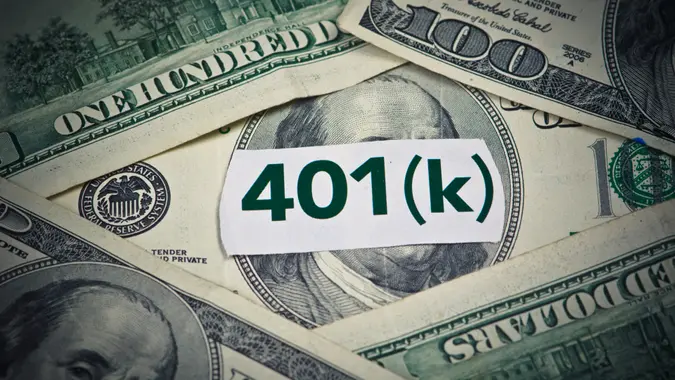Saved No Money for Retirement at Age 50? These Are Your Best Options To Catch Up

Commitment to Our Readers
GOBankingRates' editorial team is committed to bringing you unbiased reviews and information. We use data-driven methodologies to evaluate financial products and services - our reviews and ratings are not influenced by advertisers. You can read more about our editorial guidelines and our products and services review methodology.

20 Years
Helping You Live Richer

Reviewed
by Experts

Trusted by
Millions of Readers
With all of the day-to-day expenses of life, putting money away for retirement can be challenging. Over 60% of adults ages 50 and older worry that they haven’t saved up enough to live comfortably in retirement, and 1 in 5 don’t have any retirement savings at all. If you’re nearing retirement age and have nothing to show for it, it can be extremely disheartening.
However, there are things you can do to prepare yourself for retirement with the time you have. These three are excellent places to start.
Adjust Your Budget
Retirement savings doesn’t grow on trees, so you’ll need to make some changes to start building up some savings. If you already have a monthly budget, you’ll need to make some changes to it. If you don’t keep a monthly budget, you’ll need to start.
The best way to figure out where you can cut back is to track your spending for a month. Keep receipts and review your credit card bills to list all discretionary spending. When you have an idea of where your money is going, you can implement a budgeting strategy to help you put more toward savings. Here are some effective budgeting methods:
- 50/30/20 Budget: Put 50% of your income toward needs, 30% toward wants and 20% toward savings. Adjust these percentages as needed.
- Zero-Based Budget: Assign an expense to every single dollar of income at the beginning of the month and stick to your plan.
- Envelope Budget: Use envelopes and physical cash to sort out how much you can spend for each category. When the envelope is empty, you can’t spend on that category until the next month.
- Pay Yourself First Budget: Automate bank account transfers so that the day after you get a paycheck, set amounts go to savings and bills. You can then spend the rest of the money.
With a budget in place, you can funnel more money to savings accounts and invest it. This will accelerate your retirement savings.
Open a Roth IRA
Retirement funds like a Roth IRA and 401(k) allow you to save for retirement while getting tax breaks. While it’s true that the longer you have money invested, the more interest you’ll earn over time, it’s better to start late than never at all.
Roth IRAs are funds to which you can contribute a limited amount of money that you’ve already paid taxes on each year. You can then invest your money within your Roth IRA and grow it without having to worry about capital gains tax. At the age of 59 1/2, you can begin withdrawing your money and won’t have to pay any taxes on it.
Because this is such a great deal, you can only contribute $7,000 per year if you’re under 50. If you’re 50 or older, you can contribute $8,000. This means even though you’re behind on funding your retirement fund, you start putting in more each year to make up for it.
Max Out Your 401(k)
If you’re a full-time employee of a company, you likely have the option to divert part of your paycheck to a 401(k). A 401(k) is a type of retirement account funded by money before you pay taxes on it. Because of this, you’ll have to pay ordinary income tax on your withdrawals in retirement, but your investments can grow untaxed in the account.
The reason you should maximize your 401(k) distributions is that you may be eligible for an employer match. This is when your employer doubles the amount you contribute to a certain percentage. In essence, it’ll double your retirement savings for free.
More From GOBankingRates
- Nearly 1 in 3 Americans Hit by a Costly Holiday Scam, Norton Survey Shows -- How To Avoid This
- Here's What the Average Social Security Payment Will Be in Winter 2025
- How Middle-Class Earners Are Quietly Becoming Millionaires -- and How You Can, Too
- The Easiest Way to Score $250 for Things You Already Do
 Written by
Written by  Edited by
Edited by 


























